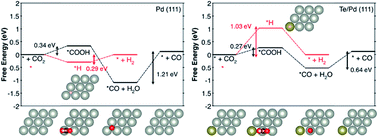当前位置:
X-MOL 学术
›
Chem. Sci.
›
论文详情
Our official English website, www.x-mol.net, welcomes your
feedback! (Note: you will need to create a separate account there.)
Doping palladium with tellurium for the highly selective electrocatalytic reduction of aqueous CO2 to CO
Chemical Science ( IF 7.6 ) Pub Date : 2017-11-06 00:00:00 , DOI: 10.1039/c7sc03018e Hengcong Tao 1, 2, 3, 4 , Xiaofu Sun 5, 6, 7, 8, 9 , Seoin Back 10, 11, 12, 13 , Zishan Han 1, 2, 3, 4 , Qinggong Zhu 5, 6, 7, 8, 9 , Alex W. Robertson 14, 15, 16, 17 , Tao Ma 1, 2, 3, 4 , Qun Fan 1, 2, 3, 4 , Buxing Han 5, 6, 7, 8, 9 , Yousung Jung 10, 11, 12, 13 , Zhenyu Sun 1, 2, 3, 4
Chemical Science ( IF 7.6 ) Pub Date : 2017-11-06 00:00:00 , DOI: 10.1039/c7sc03018e Hengcong Tao 1, 2, 3, 4 , Xiaofu Sun 5, 6, 7, 8, 9 , Seoin Back 10, 11, 12, 13 , Zishan Han 1, 2, 3, 4 , Qinggong Zhu 5, 6, 7, 8, 9 , Alex W. Robertson 14, 15, 16, 17 , Tao Ma 1, 2, 3, 4 , Qun Fan 1, 2, 3, 4 , Buxing Han 5, 6, 7, 8, 9 , Yousung Jung 10, 11, 12, 13 , Zhenyu Sun 1, 2, 3, 4
Affiliation

|
Designing highly selective and energy-efficient electrocatalysts to minimize the competitive hydrogen evolution reaction in the electrochemical reduction of aqueous CO2 remains a challenge. In this study, we report that doping Pd with a small amount of Te could selectively convert CO2 to CO with a low overpotential. The PdTe/few-layer graphene (FLG) catalyst with a Pd/Te molar ratio of 1 : 0.05 displayed a maximum CO faradaic efficiency of about 90% at −0.8 V (vs. a reversible hydrogen electrode, RHE), CO partial current density of 4.4 mA cm−2, and CO formation turnover frequency of 0.14 s−1 at −1.0 V (vs. a RHE), which were 3.7-, 4.3-, and 10-fold higher than those of a Pd/FLG catalyst, respectively. Density functional calculations showed that Te adatoms preferentially bind at the terrace sites of Pd, thereby suppressing undesired hydrogen evolution, whereas CO2 adsorption and activation occurred on the high index sites of Pd to produce CO.
中文翻译:

碲掺杂钯用于高选择性电催化将含水的CO 2还原为CO
设计高选择性和高能效的电催化剂以最小化在电化学还原含水CO 2中的竞争性放氢反应仍然是一个挑战。在这项研究中,我们报告说,用少量Te掺杂Pd可以有选择地将CO 2转化为低过电势的CO。Pd / Te摩尔比为1:0.05的PdTe /几层石墨烯(FLG)催化剂在-0.8 V时显示最大CO法拉第效率(相对于可逆氢电极RHE),CO分电流密度为4.4 mA cm -2时和-1.0 V时的CO形成转换频率为0.14 s -1(vs.RHE),分别比Pd / FLG催化剂高3.7倍,4.3倍和10倍。密度泛函计算表明,Te原子优先结合在Pd的平台位上,从而抑制了不希望有的氢的释放,而CO 2在Pd的高指数位上发生了吸附和活化,从而产生了CO。
更新日期:2017-11-15
中文翻译:

碲掺杂钯用于高选择性电催化将含水的CO 2还原为CO
设计高选择性和高能效的电催化剂以最小化在电化学还原含水CO 2中的竞争性放氢反应仍然是一个挑战。在这项研究中,我们报告说,用少量Te掺杂Pd可以有选择地将CO 2转化为低过电势的CO。Pd / Te摩尔比为1:0.05的PdTe /几层石墨烯(FLG)催化剂在-0.8 V时显示最大CO法拉第效率(相对于可逆氢电极RHE),CO分电流密度为4.4 mA cm -2时和-1.0 V时的CO形成转换频率为0.14 s -1(vs.RHE),分别比Pd / FLG催化剂高3.7倍,4.3倍和10倍。密度泛函计算表明,Te原子优先结合在Pd的平台位上,从而抑制了不希望有的氢的释放,而CO 2在Pd的高指数位上发生了吸附和活化,从而产生了CO。










































 京公网安备 11010802027423号
京公网安备 11010802027423号